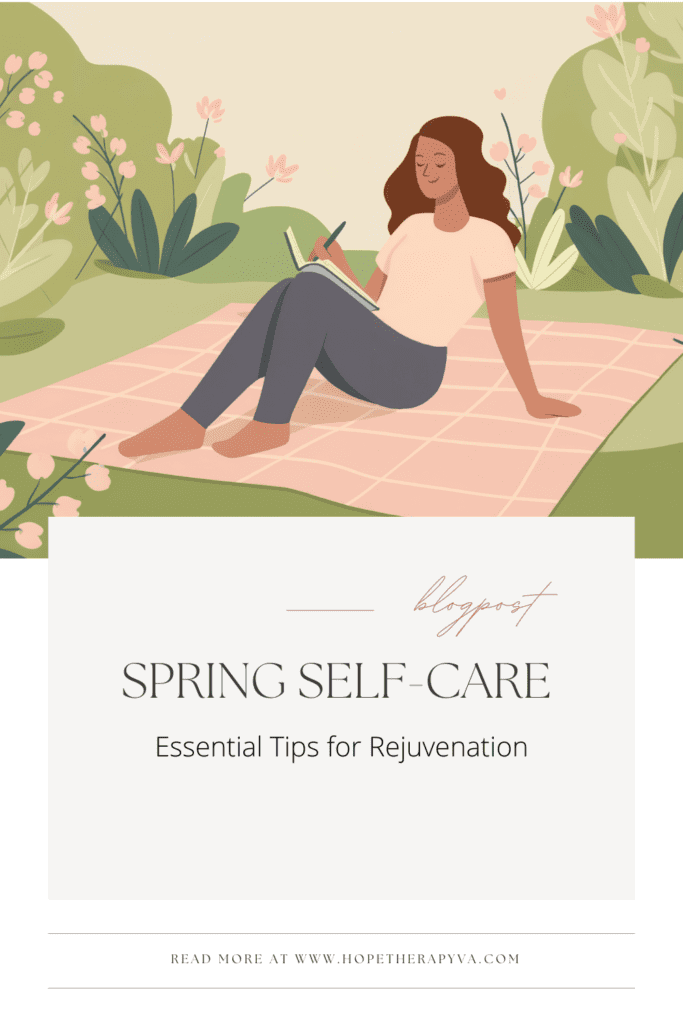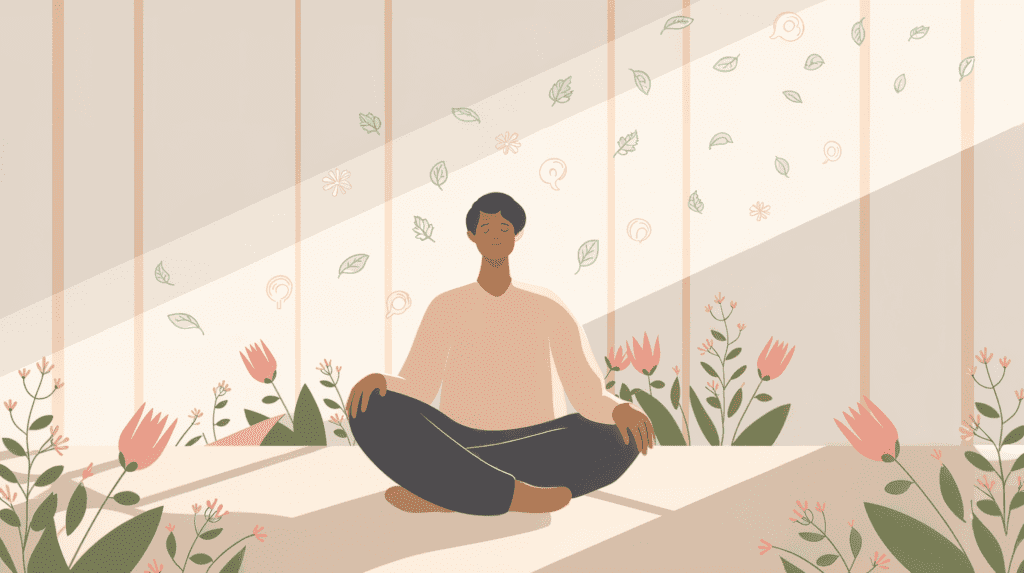As the world bursts into bloom, are you giving yourself the same fresh start?
Spring is nature’s way of saying it’s time to wake up, stretch out, and start fresh. As flowers bloom and days grow warmer, why not give yourself the same renewal? Spring is the perfect opportunity to refresh both mind and body, leaving behind the sluggish energy of winter and stepping into the season with renewed vitality.
As nature awakens, embracing a self-care routine can boost energy levels and enhance well-being.
Spring self-care involves nurturing one’s physical and mental health to shake off the winter blues and prepare for the vibrant season ahead.
Through intentional practices that focus on both the body and mind, individuals can create a balanced lifestyle that supports their overall health.

Incorporating activities that encourage physical wellbeing can elevate the benefits of spring self-care.
Outdoor exercise, nutritious meals with seasonal ingredients, and adequate rest contribute to a healthier lifestyle.
Alongside physical health, paying attention to mental and emotional health by engaging in activities such as mindfulness, journaling, or spending time in nature can help maintain a positive mindset and reduce stress.
Creating a harmonious environment also plays a vital role.
Decluttering living spaces and incorporating elements of nature indoors can uplift spirits and provide a sense of peace.
Small changes in daily routines can have lasting impacts, and adopting lifestyle enhancements that include self-care strategies can make the transition into spring a rewarding experience.
Key Takeaways
- Spring self-care boosts physical and mental health.
- Outdoor activities and nutritious meals aid well-being.
- A harmonious environment enhances lifestyle satisfaction.
Spring into Self-Care: The Essentials
Spring offers a chance for renewal and a fresh start. Engaging in self-care during this season can enhance wellbeing and provide comfort.
Understanding Self-Care
Self-care involves activities that individuals engage in to maintain their mental, emotional, and physical health.
It’s about prioritizing one’s own needs and making time for activities that rejuvenate the spirit.
Practices vary but often include balanced nutrition, regular exercise, and sufficient rest.
These elements form a foundation for restorative self-care. Integrating such activities into daily routines ensures ongoing personal care.
Mindfulness practices, like meditation or journaling, help individuals manage stress effectively.
Simple adjustments can have a profound impact, making self-care accessible for everyone seeking to improve wellbeing and comfort.
Embracing the Spring Season
Spring symbolizes new beginnings and growth. The season encourages people to connect with nature and enjoy the warmer weather.
Outdoor activities, such as walking or gardening, offer opportunities for fresh air and exercise contributing to wellness.
Seasonal self-care can include decluttering living spaces. Tidying up can create an environment that fosters relaxation and tranquility.
Engaging with nature’s beauty offers a mental respite.
Planting a small garden or trying new hobbies also bring creativity and joy. These activities support a positive mindset and provide a simple way to incorporate self-care into daily life. Engaging in these practices fosters a fresh start and encourages ongoing care.
Physical Wellbeing
Spring is a perfect time to focus on physical health.
Refreshing your skincare, enjoying fresh air, and setting up a spring fitness routine are key aspects to consider.
Refreshing Your Skincare Routine
In spring, the weather changes, making it important to adjust your skincare routine.
Warmer temperatures may require lighter products. Switching to a more hydrating moisturizer and using sunscreen daily helps protect the skin.
Exfoliation also plays a role. It removes dead skin cells, revealing a fresh layer beneath. Some opt for gentle scrubs, while others might prefer exfoliating serums. Finding what works best is important for maintaining a healthy glow through the season.
The Importance of Fresh Air and Outdoor Spaces
Spending time outside boosts overall wellbeing. Fresh air is essential for mental clarity and energy. It reduces stress and increases happiness.
Trees and plants release oxygen, cleansing the air and aiding in relaxation.
Outdoor spaces such as parks and gardens offer spaces for exercise and leisure. Activities like walking or picnicking help people connect with nature. Emphasizing this connection supports physical health and enhances mood.
Spring Fitness: Rejuvenating Your Routine
Spring is a chance to invigorate fitness routines.
Outdoor activities like hiking and biking become more enjoyable with warming weather. Finding a local trail or bike path can make exercising more engaging.
Introducing group activities might provide motivation. Joining a local sports league or starting a fitness class encourages social interaction.
Setting achievable goals ensures progress without overwhelming oneself. Maintaining consistent activity keeps the body strong and prepared for more adventures.
Nurture Your Mind & Mood

Mental and emotional well-being is crucial during spring as individuals navigate transitions and changes.
Strategies such as mindfulness, tackling loneliness, and finding personal happiness contribute significantly to maintaining balance.
Practicing Meditation and Mindfulness
Meditation and mindfulness offer effective ways to enhance mental health and foster relaxation.
These practices help individuals focus on the present moment, reducing anxiety and stress.
Daily meditation can involve simple breathing exercises or guided meditation sessions.
Mindfulness practices, like mindful eating or walking, encourage awareness in everyday activities, promoting a deeper connection with one’s thoughts and feelings.
By incorporating these habits, individuals can cultivate a sense of inner peace and clarity for greater mental stability.
Addressing Loneliness in Spring
Spring can highlight feelings of loneliness, but there are ways to address this emotional challenge.
Engaging in community activities, whether through volunteering or joining local clubs, fosters social connections and reduces feelings of isolation.
Technology also plays a role in staying connected, with video calls or social media bridging the gap between distant friends and family.
Support groups offer a safe space to share experiences and feelings with others facing similar emotions, providing comfort and companionship.
Cultivating Happiness: Finding ‘Me Time’
Finding time for oneself is a vital part of cultivating happiness and emotional health.
‘Me time’ encourages individuals to pursue activities they love, such as reading, gardening, or hobbies that bring joy and relaxation.
Setting boundaries and prioritizing personal time within daily routines can lead to improved moods and reduced stress.
Simple actions like enjoying a cup of tea in silence or taking a leisurely walk can have significant benefits for emotional well-being.
Create a Sanctuary at Home

Improving home and environment during spring can boost well-being and comfort. This involves decluttering spaces, adding indoor plants, and creating a cozy atmosphere. Here’s a closer look at how these elements come together to enhance your living environment.
The Art of Decluttering
Decluttering is an important step in spring cleaning. It involves removing items that are no longer needed or used, creating a tidy and organized space.
Using the Marie Kondo method can be helpful. This means keeping only items that spark joy. Another technique is the “one-in, one-out” rule to manage new items.
Decluttering not only improves physical space but can also reduce stress and increase productivity.
Labeling storage boxes and using clear containers also aid in keeping things organized and easy to find. Open shelves can display items neatly while keeping everything accessible.
Indoor Plants and Their Benefits
Indoor plants provide numerous benefits that enhance the home environment.
They improve air quality by removing toxins and increasing humidity.
Popular choices include spider plants, peace lilies, and snake plants. These plants are hardy and require minimal care.
Natural light is essential for their growth, so placing them near windows can be beneficial.
House plants also add a touch of nature to indoor spaces, promoting relaxation and stress reduction. Research indicates that simply looking at plants can lower blood pressure and improve mood.
Creating a Comfortable and Cozy Atmosphere
Crafting a cozy atmosphere involves embracing elements of hygge—a Danish concept of comfort and coziness.
This can be achieved through warm textiles like blankets and soft pillows.
Lighting plays a key role. Opt for soft lighting with lamps and candles to create a warm glow. Using natural light effectively can also enhance the feel of a room.
Incorporating natural materials like wood or stone can bring a calming effect. Rearranging furniture to create intimate spaces can encourage relaxation and conversation.
Small touches, such as pleasant scents from candles or essential oils, add to the welcoming atmosphere.
Fresh Starts & New Adventures

Spring offers a wonderful opportunity to try new hobbies, connect with nature through gardening, and find simple pleasures. Engaging in activities like these can boost mood and well-being.
Adopting a New Hobby This Spring
Trying a new hobby can be refreshing. Spring provides warmer weather, making it perfect to start something outdoors or indoors.
Activities like painting, crafting, or even learning photography can engage the mind and spark creativity.
Many people find joy in trying their hand at succulent gardening, where they can experiment with different plant arrangements and observe the quirks of plant growth.
Depending on interests, countless resources and online tutorials are available to help make the learning process easier.
This season is an ideal time to explore new interests and hobbies that add excitement and satisfaction to daily life.
Gardening: Connecting with Nature
Gardening is a fulfilling way to connect with nature and can be a beneficial form of self-care.
Planting a garden, even one with easy-to-care-for succulents, allows individuals to enjoy the beauty of plants as they grow.
Spending time in a garden can reduce stress, improve mood, and even boost physical health through light exercise.
Simple gardening activities, like watering plants or weeding, provide a break from daily routines.
For those with limited space, indoor gardening or container gardening can be viable alternatives. This activity allows people to witness the changing life cycles firsthand, promoting mindfulness and a sense of accomplishment.
Simple Pleasures: Treating Yourself
Finding joy in simple pleasures is an important part of self-care.
Spring is a great time to treat oneself, whether indulging in a favorite treat, spending time reading a good book, or enjoying a leisurely walk to admire blooming flowers.
Activities like these help create moments of happiness and relaxation throughout the day.
When planning these pleasures, it’s essential to prioritize personal enjoyment.
Taking a bit of time away from everyday stressors for self-indulgence can boost mental health.
Creating a self-care routine, where treating oneself becomes a regular part, can lead to a more balanced and contented lifestyle.
Conclusion

Spring is the perfect time for a fresh start. Emphasizing self-care can improve overall wellbeing during this season of renewal.
Taking small steps to enhance physical and mental health can make a significant difference.
A few self-care practices include spending more time outdoors, engaging in physical activities, and incorporating a balanced diet. These actions support a healthy lifestyle and enhance personal wellbeing.
Focusing on mindfulness can also aid in reducing stress and increasing happiness. Activities like meditation or journaling can provide emotional benefits and mental clarity.
Creating a self-care routine tailored to individual needs and preferences is important. This routine can be as simple as setting aside time for relaxation or pursuing new hobbies.
Spring offers a unique opportunity to reassess priorities. Reflecting on goals and setting new ones can help maintain a balanced lifestyle throughout the year.
Practicing self-compassion during this process can be beneficial.
Ultimately, making self-care a priority leads to positive changes. Individuals can enjoy increased energy, improved mood, and a greater sense of satisfaction. Prioritizing personal wellbeing during this season sets the stage for lasting positive change.
Frequently Asked Questions

Spring is an ideal time to refresh self-care routines, emphasizing mental well-being, effective daily practices, and using the 7 pillars of self-care. Here are some key questions addressed to help enhance wellness during this season.
What activities are recommended to improve mental health during the spring season?
Engaging in outdoor activities like walking, gardening, or cycling can boost mood and reduce stress as the days become longer and warmer.
Participating in local events and community gatherings can also foster a sense of connection and belonging.
How does changing the season to spring affect self-care routines?
The transition to spring encourages people to spend more time outdoors, benefiting from natural light, which may improve mood. Many individuals feel motivated to incorporate physical activities and mindful practices like yoga or meditation into their routines during this time.
What are some effective self-care strategies to practice daily?
Daily self-care practices include setting aside time for relaxation, maintaining a balanced diet, staying hydrated, and ensuring adequate sleep.
Adding activities like journaling or mindful breathing can further enhance overall well-being.
Can you suggest a memorable self-care quote to inspire routine practice?
A popular quote is, “You can’t pour from an empty cup. Take care of yourself first.” This serves as a reminder of the importance of prioritizing one’s own well-being to better support others.
How can the concepts of the 7 pillars of self-care be incorporated into a spring wellness plan?
The 7 pillars of self-care—knowledge, mental well-being, physical activity, healthy eating, risk avoidance, good hygiene, and rational use of products—can be integrated into spring plans.
For example, focus on fresh seasonal foods, staying active, and learning more about personal health needs.
What are the essential components to consider when creating a self-care plan?
Essential elements include assessing personal needs, setting realistic goals, and creating a balanced routine that addresses physical, emotional, and mental health.
It’s important to adapt plans to fit lifestyle changes and personal preferences, ensuring the approach remains effective and enjoyable.



